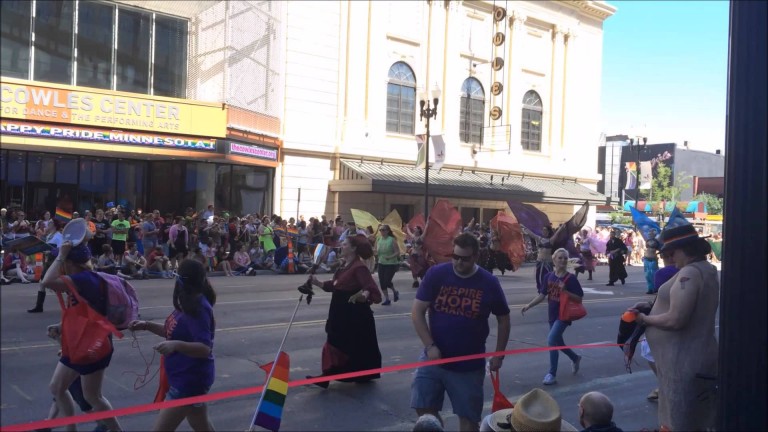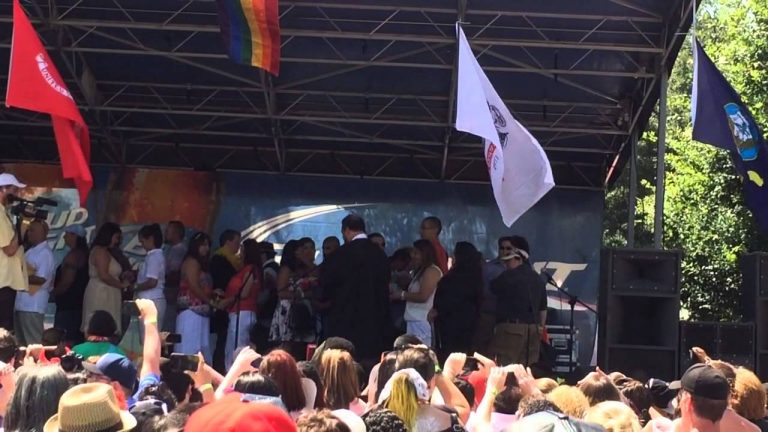A few memorable ways to make the most of a summer visit to Minneapolis
The office of tourism in Minneapolis bills this gay-friendly city “the coolest place on earth,” and they’re not kidding. The climate here is downright chilly much of the year, but in summer, when a typical July or August day might see high temperatures in the 70s, Minneapolis becomes the meteorological envy of most Americans. The city’s great summer weather sets the tone for all sorts of enjoyable activities, from leisurely bike rides to gay pride festivities to meals al fresco at one of the region’s many inviting restaurants.
Here are a few memorable ways to make the most of a summer visit to Minneapolis.
Get a bird’s eye view of the city
Especially if it’s a clear day, make a trip to the elegant 32-story Foshay Tower, a 1929 landmark building with a public observation deck that affords terrific views for miles around. After your skyscraping adventure, take the elevator down to Cafe Un Deux Trois, an excellent choice for a lunch of first-rate French fare, such as steak tartare or mussels with fries.
The Foshay Tower is roughly the geographic center of downtown; linking it to buildings on more than 50 surrounding blocks is a vast network of second-story interior skyways – these come in quite handy on the blustery winter days for which Minnesota is famous. But if you’re a shopaholic, even during the warmer months, a walk through these skyways makes for great treasure- hunting (and downtown is a far more pleasant shopping venue than the overhyped Mall of America in nearby Bloomington). Shops accessible from the 5-mile skyway system include Marshall Field’s, Neiman Marcus, Saks Fifth Avenue, and a flagship store of the Minnesota- based, and gay-employee-friendly, Target Corporation.
Related: A Seattle Shopping Spree
Take a walk through the Warehouse District
The Warehouse Historic District, west of Hennepin Avenue, is characterized by stately, old-world architecture that’s rare elsewhere downtown. The 150 buildings here contain shops, restaurants, nightclubs, a few strip clubs and adult bookstores, and a growing number of art galleries – this is a stroll that’s equally interesting day or night. Most of the upper floors of these buildings have been reconfigured as loft apartments and design studios. Note the Cass Gilbert-designed Minneapolis Van and Warehouse Company Building, now the renowned Theatre de la Jeune Lune, which specializes in cutting-edge theatrical works.
This is a great neighborhood for gay-friendly dining. Try Cafe Havana for excellent Latin American food – it’s something of a playground for posing, sipping martinis, and smoking cigars. Or stop by Cafe Brenda for delightfully fresh and inventive organic cooking, like savory wild mushroom-pistachio pate and organic mock- duck tacos. Pizza Luce, staffed with punker-kid waitrons, is where a lot of fags like to dish over deep-dish pizzas. And for arguably the finest Northern Italian fare in the city, book a table at D’Amico Cucina, which is also notable for its stunning Art Nouveau interior and 500-vintage wine list.
Make a bicycle tour of the Chain of Lakes
There are 22 lakes within Minneapolis city limits, and the most prominent of these form the Chain of Lakes, a string of azure oases southwest of downtown. The terrain is mostly flat and the traffic generally slow along the roads that circumnavigate these lakes, making this exceptional biking – or blading and jogging – territory. You can rent bikes at Calhoun Rental, which is just a couple of blocks from Lake Calhoun and Lake of the Isles; rates (for basic bikes) begin at $6 per hour, $15 per half day, and $24 per full day.
Surrounding the lake are fashionable enclaves like Bryn Mawr, Calhoun-Isles, and Kenwood, in which many of the city’s wealthiest residents built houses in the late-19th and early 20th centuries. Real estate around these lakes remains pricey, although many of the large mansions have been divvied up into apartments. Such has not been the fate of the imposing private home at 2104 Kenwood Parkway, although its depiction in the opening credits of The Mary Tyler Moore Show, as the first residence of Mary Richards, might lead you to conjecture otherwise. Go ahead and cycle by, but don’t ask the no doubt frazzled owners for a tour – curiosity seekers are said to show up occasionally expecting to find the place laid out and decorated exactly as it appeared on the show, complete with Rhoda’s fabulous beaded doorway.
The Mary house is just a couple of blocks inland from the western shore of Lake of the Isles, a particularly picturesque member in the Chain of Lakes; it’s so named for the two small isles in the center of it. Due south is the largest of these rippling waterways, Calhoun Lake, around which legions of walkers and runners make their way. The grassy eastern shores, especially between 33rd and 34th streets, tend to be particularly popular among lesbians
and gays, many of whom live in the adjoining Uptown neighborhood. Continue southeast through leafy Berry and Lyndale parks to reach Lake Harriett, the final link in the chain.
Attend a performance or festival
Minneapolis’ GLBT Pride Festival and Parade, held the last weekend in June, is one of the best-attended such events in the world, drawing more than 250,000 each year. But summer is a great time to catch all kinds of concerts, shows, and events. The Twin Cities Gay Men’s Chorus performs at the Ted Mann Concert Hall at University of Minnesota; their summer concert, which in 2002 features the Broadway tunes of Rodgers and Hammerstein, is set for two nights during Gay Pride weekend.
After New York City, Minneapolis has the most theater seats per capita in the United States – there are dozens of venues throughout the city, from the famous Guthrie, the country’s largest regional theater, to cutting-edge spaces like the Hey City and Mixed Blood theaters, which often present works with lesbian, feminist, or gay themes.
Take a stroll around Loring Park
On the southwest edge of downtown, you’ll find one of Minneapolis’ most inviting green spaces, Loring Park, a seeming slice of small-town America that’s just steps from a clutch of modern office towers. Here a true mix of Minneapolitans wanders around the grassy shores of the park’s central pond, feeding ducks and enjoying the scenery. This is where the aforementioned gay pride parade commences the last weekend in June, and where Mary Richards seems to thank the stars for life in Minneapolis during the opening credits of The Mary Tyler Moore Show. (In a related note, a statue of MTM tossing her hat in the air, also as she does in the show’s credits, was unveiled at 7th Street and Nicollet Mall in May 2002).
A short street called Harmon Place fringes the north edge of the park and houses some neoboho shops and eateries, including the urbane Loring Cafe, which comprises an avant-garde theater, a relentlessly counter- cultural bar (with its own light menu), and a more formal dining room where you can sample tasty delicacies like chilled, seared ahi tuna. A couple of doors down, Joe’s Garage serves tasty global fare with such eclectic offerings as basil-pesto turkey burgers and red Thai curry-and-mushroom risotto. The restaurant’s motto, “Food fit for a king…and a few queens,” should clue you in to the giddy clientele. You can always order food to go at one of the above restaurants and enjoy your meal outside in the park. There may be no more perfect ending to a beautiful summer day in Minneapolis than a picnic with friends or your honey beside the pond in verdant Loring Park.






